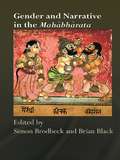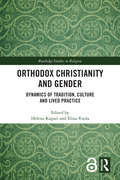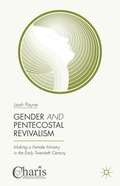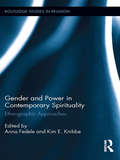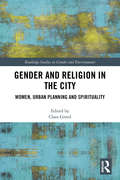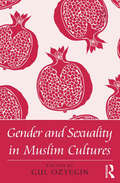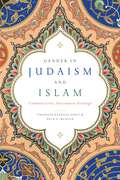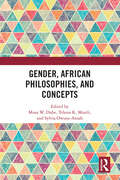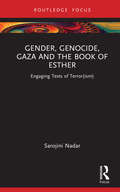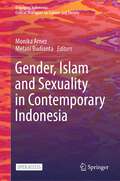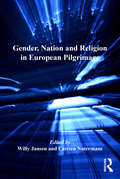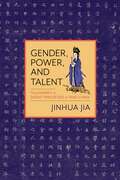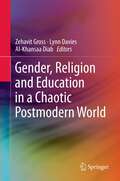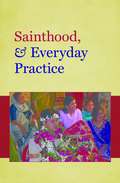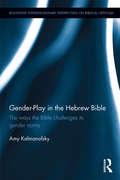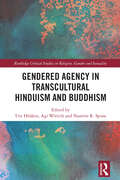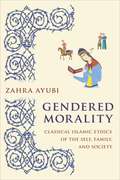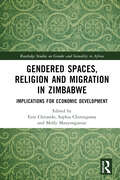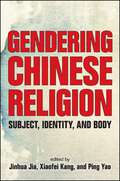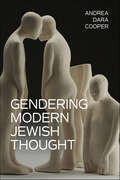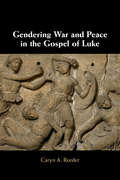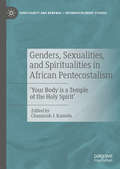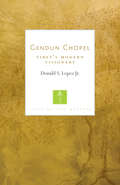- Table View
- List View
Gender and Narrative in the Mahabharata (Routledge Hindu Studies Series)
by Simon Brodbeck Brian BlackThe Sanskrit Mahabharata is one of the most important texts to emerge from the Indian cultural tradition. At almost 75,000 verses it is the longest poem in the world, and throughout Indian history it has been hugely influential in shaping gender and social norms. In the context of ancient India, it is the definitive cultural narrative in the construction of masculine, feminine and alternative gender roles. This book brings together many of the most respected scholars in the field of Mahabharata studies, as well as some of its most promising young scholars. By focusing specifically on gender constructions, some of the most innovative aspects of the Mahabharata are highlighted. Whilst taking account of feminist scholarship, the contributors see the Mahabharata as providing an opportunity to frame discussion of gender in literature not just in terms of the socio-historical roles of men and women. Instead they analyze the text in terms of the wider poetic and philosophical possibilities thrown up by the semiotics of gendering. Consequently, the book bridges a gap in text-critical methodology between the traditional philological approach and more recent trends in gender and literary theory. Gender and Narrative in the Mahabharata will be appreciated by readers interested in South Asian studies, Hinduism, religious studies and gender studies.
Gender and Orthodox Christianity: Dynamics of Tradition, Culture and Lived Practice (Routledge Studies in Religion)
by Elina Vuola Helena KupariThe Orthodox Christian tradition has all too often been sidelined in conversations around contemporary religion. Despite being distinct from Protestantism and Catholicism in both theology and practice, it remains an underused setting for academic inquiry into current lived religious practice. This collection, therefore, seeks to redress this imbalance by investigating modern manifestations of Orthodox Christianity through an explicitly gender-sensitive gaze. By addressing attitudes to gender in this context, it fills major gaps in the literature on both religion and gender. Starting with the traditional teachings and discourses around gender in the Orthodox Church, the book moves on to demonstrate the diversity of responses to those narratives that can be found among Orthodox populations in Europe and North America. Using case studies from several countries, with both large and small Orthodox populations, contributors use an interdisciplinary approach to address how gender and religion interact in contexts such as, iconography, conversion, social activism and ecumenical relations, among others. From Greece and Russia to Finland and the USA, this volume sheds new light on the myriad ways in which gender is manifested, performed, and engaged within contemporary Orthodoxy. Furthermore, it also demonstrates that employing the analytical lens of gender enables new insights into Orthodox Christianity as a lived tradition. It will, therefore, be of great interest to scholars of both Religious Studies and Gender Studies.
Gender and Pentecostal Revivalism
by Leah PayneThis innovative volume provides an interdisciplinary, theoretically innovative answer to an enduring question for Pentecostal/charismatic Christianities: how do women lead churches? This study fills this lacuna by examining the leadership and legacy of two architects of the Pentecostal movement - Maria Woodworth-Etter and Aimee Semple McPherson.
Gender and Power in Contemporary Spirituality: Ethnographic Approaches (Routledge Studies in Religion #26)
by Anna Fedele Kim E. KnibbeThis book explores the entanglements of gender and power in spiritual practices and analyzes strategies used by spiritual practitioners to attain what to social scientists might seem an impossible goal: creating spiritual communities without creating gendered hierarchies. What strategies do people within these networks use to attain gender equality and gendered empowerment? How do they try to protect and develop individual freedom? How do gender and power nevertheless play a role? The chapters in this book together and separately demonstrate that, in order to understand contemporary spirituality, the analytical lenses of gender and power are essential. Furthermore, they show that it is not possible to make a clear distinction between established religions and contemporary spirituality: the two sometimes overlap, and at other times spirituality distances itself from religion while reproducing some of its underlying interpretative frameworks. This book does not take the discourses of spiritual practitioners for granted, yet recognizes the reflexivity of spiritual practitioners and the reciprocal relationship between spirituality and disciplines such as anthropology. The ethnographic descriptions of lived spirituality included in this volume span a wide range of countries, from Portugal, Italy, and the Netherlands to Mexico and Israel.
Gender and Power in Medieval Exegesis
by Theresa TinkleAfter establishing a feminist-historicist perspective on the tradition of biblical commentary, Tinkle develops in-depth case studies that situate scholars reading the bible in three distinct historical moments, and in so doing she exposes the cultural pressures that medieval scholars felt as they interpreted the bible.
Gender and Religion in the City: Women, Urban Planning and Spirituality (Routledge Studies in Gender and Environments)
by Clara GreedThis book provides a conceptual, historical and contemporary context to the relationships between gender, religion and cities. It draws together these three components to provide an innovative view of how religion and gender interact and affect urban form and city planning. While there have been many books that deal with religion and cities; gender and cities; and gender and religion, this book is unique in bringing these three subjects together. This trio of inter-relationships is first explored within Western Christianity: in Roman Catholicism, Protestantism, Eastern Orthodoxy and in the Pentecostal and Charismatic movements. A wider perspective is then provided in chapters on the ways in which Islam shapes urban development and influences the position of Muslim women in urban space. While official religions have declined in the West there is still a desire for new forms of spirituality, and this is discussed in chapters on municipal spirituality and on the rise of paganism and the links to both environmentalism and feminism. Finally, ways of taking into account both gender and religion within the statutory urban planning system are presented. This book will be of great interest to those researching environment and gender, urban planning and sustainability, human geography and religion.
Gender and Sexuality in Muslim Cultures
by Gul OzyeginA must-read for anyone interested in Muslim cultures, this volume not only explores Muslim identities through the lens of sexuality and gender - their historical and contemporary transformations and local and global articulations - but also interrogates our understanding of what constitutes a ’Muslim’ identity in selected Muslim-majority countries at this pivotal historical moment, characterized by transformative destabilizations in which national, ethnic, and religious boundaries are being re-imagined and re-made. Contributors take on the most fundamental questions at the intersections of gender, sexuality, and the body. Several overarching questions frame the volume: How does studying gender and sexuality expand and enrich our understanding of Muslim-majority countries, historically and at present? How does the embodiment of ’Muslim’ identity get reconfigured in the context of twenty-first-century globalism? What analytical questions are raised about ’Islam’ when its diverse meanings and multifaceted expressions are closely examined? What roles do gender and sexuality play in the construction of cultural, religious, nationalistic, communal, and militaristic identities? How have power struggles been signified in and on the bodies of women and sexuality? How have global dynamics, such as the intensification and spread of neoliberal ideologies and policies, affected changing dynamics of gender and sexuality in specific locales? Here global dynamics touch down in diverse contexts, from masculinity crises around war disabilities, transnational marriages, and fathering in Turkey, Egypt, and Pakistan; to Muslim femininity narratives around female genital cutting, sexuality in divorce proceedings, and spouse selection; to gender crossing practices as well as protesting bodies, queering voices, and claims of authenticity in literary and political discourse. This book brings exciting research on these and other topics together in one place, allowing the essa
Gender and Timebound Commandments in Judaism
by Elizabeth Shanks AlexanderThe rule that exempts women from rituals that need to be performed at specific times (so-called timebound, positive commandments) has served for centuries to stabilize Jewish gender. It has provided a rationale for women's centrality at home and their absence from the synagogue. Departing from dominant popular and scholarly views, Elizabeth Shanks Alexander argues that the rule was not conceived to structure women's religious lives, but rather became a tool for social engineering only after it underwent shifts in meaning during its transmission. Alexander narrates the rule's complicated history, establishing the purposes for which it was initially formulated and the shifts in interpretation that led to its being perceived as a key marker of Jewish gender. At the end of her study, Alexander points to women's exemption from particular rituals (Shema, tefillin, and Torah study), which, she argues, are better places to look for insight into rabbinic gender.
Gender in Judaism and Islam: Common Lives, Uncommon Heritage
by Firoozeh Kashani-Sabet & Beth S. WengerJewish andIslamic histories have long been interrelated. Both traditions emerged fromancient cultures born in the Middle East and both are rooted in texts andtraditions that have often excluded women. At the same time, both groups haverecently seen a resurgence in religious orthodoxy among women, as well asgrowing feminist movements that challenge traditional religious structures. In theUnited States, Jews and Muslims operate as minority cultures, carving out aplace for religious and ethnic distinctiveness. The time is ripe for a volumethat explores the relationship between these two religions through the prism ofgender.Gender in Judaism and Islam brings togetherscholars working in the fields of Judaism and Islam to address a diverse rangeof topics, including gendered readings of texts, legal issues in marriage anddivorce, ritual practices, and women's literary expressionsand historical experiences, along with feminist influences within the Muslimand Jewish communities and issues affecting Jewish and Muslim women incontemporary society. Carefully crafted, including section introductions by theeditors to highlight big picture insights offered by the contributors, thevolume focuses attention on the theoretical innovations that gender scholarshiphas brought to the study of Muslim and Jewish experiences.At a timewhen Judaism and Islam are often discussed as though they were inherently atodds, this book offers a much-needed reconsideration of the connections andcommonalties between these two traditions. It offers new insights into each ofthese cultures and invites comparative perspectives that deepen ourunderstanding of both Islam and Judaism.
Gender, African Philosophies, and Concepts
by Musa W. Dube Telesia K. Musili Sylvia Owusu-AnsahThis volume sets out to explore, propose, and generate feminist theories based on African indigenous philosophies and concepts. It investigates specific philosophical and ethical concepts that emerge from African indigenous religions and considers their potential for providing feminist imagination for social justice-oriented earth communities. The contributions examine African indigenous concepts such as Ubuntu, ancestorhood, trickster discourse, Mupo, Akwaaba, Tukumbeng, Eziko, storytelling, and Ngozi . They look to deconstruct oppressive social categories of gender, class, ethnicity, race, colonialism, heteronormativity, and anthropocentricism. The book will be of interest to scholars of religion, philosophy, gender studies, and African studies.
Gender, Genocide, Gaza and the Book of Esther: Engaging Texts of Terror(ism) (Rape Culture, Religion and the Bible)
by Sarojini NadarGender, Genocide, Gaza and the Book of Esther bridges the gap between gendered and geopolitical analyses by interrogating both the sexual and ethnic violence embedded in the Book of Esther. While much scholarship has examined the potential genocide of the Jews in the narrative, far less attention has been paid to the Persian “retaliation genocide.” Framed within decolonial feminist perspectives, this book shifts between the harem—the royal institution where women were sequestered for the king’s use—and herem, the practice of divinely sanctioned warfare that justifies the extermination of an enemy. Rather than operating as discrete forms of violence, the book argues that the harem and the herem are co-constitutive, revealing how gendered and ethnic domination function in tandem. Through a combination of narrative inquiry, inter-textual readings, critical discourse analysis, and theological assessments of both the biblical text and its contemporary reception, Gender, Genocide, Gaza and the Book of Esther invites interpreters to consider the larger frameworks of ethnicity and racialization within which hermeneutics of sexual violence take place. A close literary reading of Esther is paired with an analysis of its contemporary geopolitical appropriations, particularly its use in Christian Zionist rhetoric. The explicit invocation of the Amalekite extermination trope by Israel’s prime minister in October 2023 to justify attacks on Gaza, underscores the enduring political afterlives of texts of terror. This book contends that a feminist reading of Esther cannot limit itself to an analysis of sexual violence but must extend its critique intersectionally, engaging with the broader necropolitical economies that structure both ancient and modern deployments of biblical violence.
Gender, Islam and Sexuality in Contemporary Indonesia (Engaging Indonesia)
by Melani Budianta Monika ArnezThis Open Access book explores the complex interplay between gender, Islam and sexuality in Indonesia, the country with the world's largest Muslim population. The authors offer a fresh look at the tensions between the local and the global through a wide range of cultural expressions and productions, including fashion, Islamic dating, popular literature, and videos on YouTube. The book is grouped around three core themes: sexuality and violence, halal lifestyle, and shame and self-determination. The first section unpacks how activists and progressive religious scholars have argued for the need for the Sexual Violence Bill and it examines the ambivalence between criminalisation and care towards LGBTQ+ people. In the second, the authors bring new insights into how local expressions of Islam, gender and sexuality are negotiated in an increasingly globalised world. The contributions on the third theme tackle gender roles and mobility in culturally diverse regions such as Hong Kong,Taiwan, Singapore, the US, and Indonesia. "The volume is a must-read for anyone wanting to get up to speed on changes in Indonesia's gender, sexuality and Islamic landscape." - Professor Sharyn Graham Davies, Director of the Herb Feith Indonesia Engagement Centre, Monash University, Australia "A showcase of excellent research, this book is of appeal to Indonesian studies scholars, and to readers in the field of Asian cultural studies. It is also of relevance to the field of Asian gender and sexuality studies, and to scholars in Islamic studies." - Professor Pamela Nilan, University of Newcastle, Australia
Gender, Nation and Religion in European Pilgrimage: Old Routes New Journeys
by Catrien NotermansDespite the forces of secularization in Europe, old pilgrimage routes are attracting huge numbers of people and given new meanings in the process. In pilgrimage, religious or spiritual meanings are interwoven with social, cultural and politico-strategic concerns. This book explores three such concerns under intense debate in Europe: gender and sexual emancipation, (trans)national identities in the context of migration, and European unification and religious identifications in a changing religious landscape. The interdisciplinary contributions to this book explore a range of such controversies and issues including: Africans renewing family ties at Lourdes, Swedish women at midlife or young English men testing their strength on the Camino to Santiago de Compostela, New Age pilgrims and sexuality, Saints’ festivals in Spain and Brittany, conservative Catholics challenging Europe’s liberal policies on abortion, Polish migrants and French Algerians reconfiguring their transnational identity by transporting their familiar Madonna to their new home, new sacred spaces created such as the shrine of Our Lady of Santa Cruz, traditional Christian saints such as Mary Magdalene given new meanings as new age goddess, and foundation legends of shrines revived by new visionaries. Pilgrimage sites function as nodes in intersecting networks of religious discourses, geographical routes and political preoccupations, which become stages for playing out the boundaries between home and abroad, Muslims and Christians, pilgrimage and tourism, Europe and the world. This book shows how the old routes of Europe are offering inspirational opportunities for making new journeys.
Gender, Power, and Talent: The Journey of Daoist Priestesses in Tang China
by Jinhua JiaDuring the Tang dynasty (618–907), changes in political policies, the religious landscape, and gender relations opened the possibility for Daoist women to play an unprecedented role in religious and public life. Women, from imperial princesses to the daughters of commoner families, could be ordained as Daoist priestesses and become religious leaders, teachers, and practitioners in their own right. Some achieved remarkable accomplishments: one wrote and transmitted texts on meditation and inner cultivation; another, a physician, authored a treatise on therapeutic methods, medical theory, and longevity techniques. Priestess-poets composed major works, and talented priestess-artists produced stunning calligraphy.In Gender, Power, and Talent, Jinhua Jia draws on a wealth of previously untapped sources to explain how Daoist priestesses distinguished themselves as a distinct gendered religious and social group. She describes the life journey of priestesses from palace women to abbesses and ordinary practitioners, touching on their varied reasons for entering the Daoist orders, the role of social and religious institutions, forms of spiritual experience, and the relationships between gendered identities and cultural representations. Jia takes the reader inside convents and cloisters, demonstrating how they functioned both as a female space for self-determination and as a public platform for both religious and social spheres. The first comprehensive study of the lives and roles of Daoist priestesses in Tang China, Gender, Power, and Talent restores women to the landscape of Chinese religion and literature and proposes new methodologies for the growing field of gender and religion.
Gender, Religion and Education in a Chaotic Postmodern World
by Lynn Davies Al-Khansaa Diab Zehavit GrossThe immense changes that the world is undergoing in terms of globalization and migration of peoples have had a profound effect on cultures and identities. The question is whether this means shifts in religious identities for women and men in different contexts, whether such shifts are seen as beneficial, negative or insufficient, or whether social change actually means new conservatisms or even fundamentalisms. Surrounding these questions is the role of education is in any change or new contradiction. This unique book enhances an interdisciplinary discourse about the complex intersections between gender, religion and education in the contemporary world. Literature in the social sciences and humanities have expanded our understanding of women's involvement in almost every aspect of life, yet the combined religious/educational aspect is still an under-studied and often under-theorized field of research. How people experience their religious identity in a new context or country is also a theme now needing more complex attention. Questions of the body, visibility and invisibility are receiving new treatments. This book fills these gaps. The book provides a strong comparative perspective, with 15 countries or contexts represented. The context of education and learning covers schools, higher education, non-formal education, religious institutions, adult literacy, curriculum and textbooks. Overall, the book reveals a great complexity and often contradiction in modern negotiations of religion and secularism by girls and boys, women and men, and a range of possibilities for change. It provides a theoretical and practical resource for researchers, religious and educational institutions, policy makers and teachers.
Gender, Sainthood, and Everyday Practice in South Asian Shi’ism
by Karen G. RuffleIn this study of devotional hagiographical texts and contemporary ritual performances of the Shi'a of Hyderabad, India, Karen Ruffle demonstrates how traditions of sainthood and localized cultural values shape gender roles. Ruffle focuses on the annual mourning assemblies held on 7 Muharram to commemorate the battlefield wedding of Fatimah Kubra and her warrior-bridegroom Qasem, who was martyred in 680 C.E. at the battle of Karbala, Iraq, before their marriage was consummated.Ruffle argues that hagiography, an important textual tradition in Islam, plays a dynamic role in constructing the memory, piety, and social sensibilities of a Shi'i community. Through the Hyderabadi rituals that idealize and venerate Qasem, Fatimah Kubra, and the other heroes of Karbala, a distinct form of sainthood is produced. These saints, Ruffle explains, serve as socioethical role models and religious paragons whom Shi'i Muslims aim to imitate in their everyday lives, improving their personal religious practice and social selves. On a broader community level, Ruffle observes, such practices help generate and reinforce group identity, shared ethics, and gendered sensibilities. By putting gender and everyday practice at the center of her study, Ruffle challenges Shi'i patriarchal narratives that present only men as saints and brings to light typically overlooked women's religious practices.
Gender-Play in the Hebrew Bible: The Ways the Bible Challenges Its Gender Norms (Routledge Interdisciplinary Perspectives on Biblical Criticism)
by Amy KalmanofskyThough the Hebrew Bible often reflects and constructs a world that privileges men, many of its narratives play extensively with the gender norms of the society in which they were written. Drawing from feminist, masculinity and queer studies, Gender-Play in the Hebrew Bible uses close literary analysis to argue that the writers of the Bible intentionally challenge gender norms in order to reveal the dangers of destabilizing societal and theological hierarchies that privilege men and masculinity. This book presents a fascinating argument about the construction and import of gender in the biblical narratives, and will be of great interest to academics in the fields of religion, theology, and Biblical studies as well as gender studies.
Gendered Agency in Transcultural Hinduism and Buddhism (ISSN)
by Nanette R. Spina Ute Hüsken Agi WittichFocusing on complex entanglements of religion and gender from a diversity of perspectives, this book explores how women enact agencies in transcultural Hindu and Buddhist settings. The chapters draw on original, in-depth empirical research in various contexts in South Asian religious traditions. Today, in an increasing number of such contexts, women are able to undergo monastic and priestly education, receive ordination/initiation as nuns and priestesses, and are accepted as ascetic religious leaders. They are starting to establish new religious communities within conservative traditions, occupying religious leadership positions on par with men. This volume considers the historical background, contemporary trajectories, and potential impact of the emergence of these new and powerful female agencies in conservative South Asian religious traditions. It will be of particular interest to scholars of religion, women’s and gender studies, and South Asian studies.
Gendered Morality: Classical Islamic Ethics of the Self, Family, and Society
by Zahra M. AyubiIslamic scriptural sources offer potentially radical notions of equality. Yet medieval Islamic philosophers chose to establish a hierarchical, male-centered virtue ethics. In Gendered Morality, Zahra Ayubi rethinks the tradition of Islamic philosophical ethics from a feminist critical perspective. She calls for a philosophical turn in the study of gender in Islam based on resources for gender equality that are unlocked by feminist engagement with the Islamic ethical tradition.Developing a lens for a feminist philosophy of Islam, Ayubi analyzes constructions of masculinity, femininity, and gender relations in classic works of philosophical ethics. In close readings of foundational texts by Abu Hamid Muhammad al-Ghazali, Nasir-ad Din Tusi, and Jalal ad-Din Davani, she interrogates how these thinkers conceive of the ethical human being as an elite male within a hierarchical cosmology built on the exclusion of women and nonelites. Yet in the course of prescribing ethical behavior, the ethicists speak of complex gendered and human relations that contradict their hierarchies. Their metaphysical premises about the nature of the divine, humanity, and moral responsibility indicate a potential egalitarian core. Gendered Morality offers a vital and disruptive new perspective on patriarchal Islamic ethics and metaphysics, showing the ways in which the philosophical tradition can support the aims of gender justice and human flourishing.
Gendered Spaces, Religion and Migration in Zimbabwe: Implications for Economic Development (Routledge Studies on Gender and Sexuality in Africa)
by Ezra Chitando Sophia Chirongoma Molly ManyonganiseThis book explores the intersections of gender, religion and migration within the context of post-independent Zimbabwe, with a specific focus on how gender disparities impact economic development. By demonstrating how these interconnections impact women’s and girls’ lived realities, the book addresses the need for gender equity, gender inclusion and gender mainstreaming in both religious and societal institutions. The book assesses the gender and migration nexus in Zimbabwe and examines the impact of religio-cultural ideologies on the status of women. In doing so, it assesses the transition of Zimbabwean women across spaces and provides insights into the practical strategies that can be utilised to improve their status both “at home” and “on the move”. Furthermore, chapters show how space continues to be genderised in ways that perpetuate structural inequality to challenge the exclusion of women from key social processes. Contributing to ongoing scholarly debates on gender in Africa, this book will be of interest to academics and students of Gender Studies, Women’s Studies, African Studies, Development Studies as well as advocators of human rights and gender activists.
Gendering Chinese Religion: Subject, Identity, and Body
by Jinhua Jia; Xiaofei Kang; Ping YaoGendering Chinese Religion marks the emergence of a subfield on women, gender, and religion in China studies. Ranging from the medieval period to the present day, this volume departs from the conventional and often male-centered categorization of Chinese religions into Confucianism, Buddhism, Daoism, and popular religion. It makes two compelling arguments. First, Chinese women have deployed specific religious ideas and rituals to empower themselves in various social contexts. Second, gendered perceptions and representations of Chinese religions have been indispensable to the historical and contemporary construction of social and political power. The contributors use innovative ways of discovering and applying a rich variety of sources, many previously ignored by scholars. While each of the chapters in this interdisciplinary work represents a distinct perspective, together they form a coherent dialogue about the historical importance, intellectual possibilities, and methodological protocols of this new subfield.
Gendering Modern Jewish Thought (New Jewish Philosophy and Thought)
by Andrea Dara CooperThe idea of brotherhood has been an important philosophical concept for understanding community, equality, and justice. In Gendering Modern Jewish Thought, Andrea Dara Cooper offers a gendered reading that challenges the key figures of the all-male fraternity of twentieth-century Jewish philosophy to open up to the feminine.Cooper offers a feminist lens, which when applied to thinkers such as Franz Rosenzweig and Emmanuel Levinas, reveals new ways of illuminating questions of relational ethics, embodiment, politics, and positionality. She shows that patriarchal kinship as models of erotic love, brotherhood, and paternity are not accidental in Jewish philosophy, but serve as norms that have excluded women and non-normative individuals.Gendering Modern Jewish Thought suggests these fraternal models do real damage and must be brought to account in more broadly humanistic frameworks. For Cooper, a more responsible and ethical reading of Jewish philosophy comes forward when it is opened to the voices of mothers, sisters, and daughters.
Gendering War and Peace in the Gospel of Luke
by Caryn A. ReederIn this book, Caryn A. Reeder examines the gendered language and imagery of war and peace in the Gospel of Luke. Peace is represented with the blessing of fertility, pregnancy, and newborn infants. Pregnant and nursing women, women and children in general, and feminized Jerusalem also represent the horrors of war in the Gospel - abandoned, crushed to the ground, subject to woe and distress, to the point that barren wombs and dry breasts become a blessing. Reeder argues that the representation of peace with pregnant women and newborn infants, the most vulnerable in the population, indicates that victory belongs to God. This message is clarified by the encouragement of surrender and flight from besieged Jerusalem, rather than an active defense. Notably, there are no men to defend Jerusalem in Luke's warnings of war. The Gospel undermines the masculinization of war commonly found in Greco-Roman texts by redirecting the means of making peace from the violence of victory to the unmanly act of surrender.
Genders, Sexualities, and Spiritualities in African Pentecostalism: 'Your Body is a Temple of the Holy Spirit' (Christianity and Renewal - Interdisciplinary Studies)
by Chammah J. KaundaThis book examines the complex and multifaceted nature of African Pentecostal engagements with genders and sexualities. In the last three decades, African Pentecostalism has emerged as one the most visible and profound aspects of religious change on the continent, and is a social force that straddles cultural, economic, and political spheres. Its conventional and selective literal interpretations of the Bible with respect to gender and sexualities are increasingly perceived as exhibiting a strong influence on many aspects of social and public institutions and their moral orientations. This collection features articles which examine sexualities and genders in African Pentecostalism using interdisciplinary methodological and theoretical approaches grounded within traditional African thought systems, with the goal of enabling a broader understanding of Pentecostalism and sexualities in Africa.
Gendun Chopel: Tibet's Modern Visionary (Committee On Publications In Biology And Medicine Ser.)
by Donald S. LopezThe most comprehensive work available on the life and writings of Tibet's most famous modern cultural hero.Visionary, artist, poet, iconoclast, philosopher, adventurer, master of the arts of love, tantric yogin, Buddhist saint. These are some of the terms that describe Tibet’s modern culture hero Gendun Chopel (1903–1951). The life and writings of this sage of the Himalayas mark a key turning point in Tibetan history, when twentieth-century modernity came crashing into Tibet from British India to the south and from Communist China to the east. For the first time, the astonishing breadth of his remarkable accomplishments is captured in a single, definitive volume. Here is an exploration of Gendun Chopel’s life as a recognized tulku, or incarnation of a previous master, becoming a monk and soon surpassing the knowledge of his teachers, to his travels and discoveries throughout Tibet, India, and Sri Lanka. His exposure to the wider world brought together his philosophical training, artistic virtuosity, and meditative experience, inspiring an incredible corpus of poetry, prose, and painting. While Gendun Chopel was known by the Tibetan establishment for his vast learning and progressive ideas—which eventually landed him in a Lhasa prison—he was little appreciated in his lifetime. However, since his death in 1951 his legacy, fame, and relevance across the Tibetan cultural landscape and beyond have continued to grow.No American scholar knows Gendun Chopel better than Donald Lopez, who has written six books about him, culminating in this volume. Lopez intimately and eloquently carries the reader through the life of Gendun Chopel and sets the stage for his selected writings, which present the range and depth of Gendun Chopel’s thought. The most comprehensive and wide-ranging work available on this extraordinary figure, this inaugural book of the Lives of the Masters series is an instant classic.
